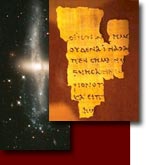| Site Map | Contacts | Links | Newsletter | |
The Bible:
King James Version
Original King James Version 1611 is below. See if you can read it.
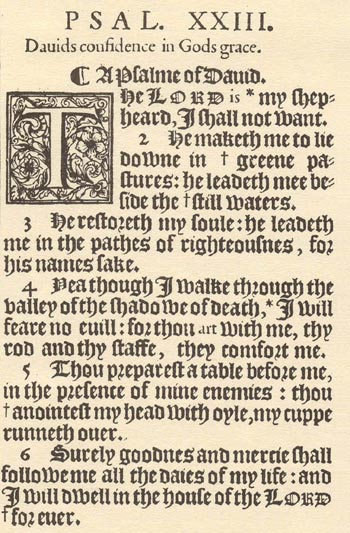
In case you could not read it, it is Psalm 23.
When I moved down to the South to attend a very conservative Christian University, I found a number of students at this school were KJV only. This was a hotly debated subject. They reason, that if the Bible is inspired by God it must be perfect, which Bible is the perfect one? The KJV is! Just read the beautifully poetic 23rd Psalm. The "thou's" give the KJV an air of majesty. You correct the Hebrew and Greek with the KJV. Most of them never studied Hebrew or Greek. There is no need to. Missionaries do not translate the Bible, you teach the natives to learn English so they can read the perfect KJV.
I should say that I like the KJV. It is a very interesting translation. It was not until I began to study the origins of the English language, Old English, Middle English, Early Modern English, and modern English, that I was able to appreciate the KJV. (See The Origins and Development of the English Language by Thomas Pyles and John Algeo).
Major Problems
- In the preface to the KJV 1611 the translators do not claim that this
is an inspired perfect translation. (See The Holy Bible 1611 Edition:
King James Version published by Thomas Nelson Publishers, 1982; reprint
of the 1611 KJV). See also Translating for King James: Notes made by
a translator(John Bois) of the King James's Bible translated by Ward
Allen published by Vanderbilt University Press, 1969. The translators
noted the differences in the Greek texts. The marginal note of Luke 17:36
states, "This 36th verse is wanting in most of the Greek copies."
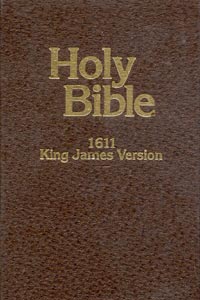
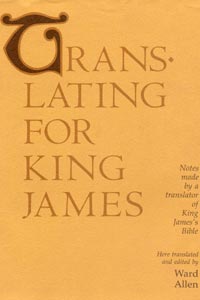
The Holy Bible 1611 Edition: King James Version published by Thomas Nelson Publishers, 1982; reprint of the 1611 KJV. Translating for King James: Notes made by a translator(John Bois) of the King James's Bible translated by Ward Allen published by Vanderbilt University Press, 1969.
- The KJV translators were limited in the manuscripts available to them.
The Dead Sea Scrolls had not been discovered yet (1947). (See The Dead
Sea Scroll Bible: The Oldest Known Bible Translated For the First Time
into English by Abegg, Flint, and Ulrich, published by Harper San
Fancisco, 1999; also see The Text of the Old Testament by Ernst
Wurthwein published by Eerdmans, 1979; Textual Criticism: Recovering
the Text of the Hebrew Bible by P. Kyle McCarter published by Fortress
Press, 1986). Ancient Greek manuscripts had not yet been uncovered. Aleph,
a fourth century AD codex, was discovered in 1859 by Tischendorf
in the monastery of St. Catharine at Mt. Sinai. Codex Vaticanus from fourth
century AD at the great Vatican Library at Rome was not made available
until a photographic facsimile was published in 1889-90.(See The Text
of the New Testament By Bruce Metzger published by Oxford University
Press, 1964).
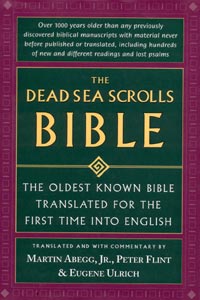
The Dead Sea Scroll Bible: The Oldest Known Bible Translated For the First Time into English by Abegg, Flint, and Ulrich, published by HarperSanFancisco, 1999.
- The current KJV being printed differs in a number of details from the
KJV 1611. There are also numerous printing errors in different editions
of the KJV. The 1611 editions have "Then cometh Judas" instead
of "Then cometh Jesus" in Matthew 26:36. There is the "Wicked
Bible" edition of the KJV where "not" is omitted from the
seventh commandment saying, "thou shalt commit adultery." William
Kilburne in 1659 found 20,000 errors in six different KJV's. In 1701 Bishop
Lloyd added the chronology of Bishop Ussher. Even today there are differences
between the KJV published by Oxford, Cambridge, and Nelson publishers
(See The English Bible from KJV to NIV: A History and Evaluation
by Jack P. Lewis, published by Baker, 1981).
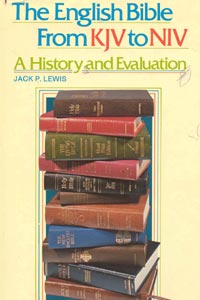
The English Bible from KJV to NIV: A History and Evaluation by Jack P. Lewis, published by Baker, 1981. A number of Church leaders in the 19th century realized that there were numerous translation errors in the KJV and called for a new translation which resulted in American Standard Version. The KJV is about 92% the same as the Tyndale translation.
- The original KJV 1611 included the Apocrypha. Is only part of the KJV
1611 or is all of it inspired by God? How can it be the perfect translation
if it has the Apocrypha?
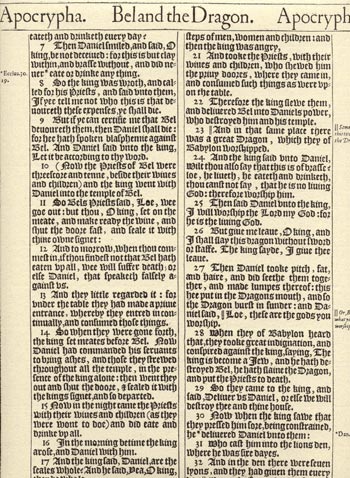
-
There are a number of places especially in the Book of Revelation where there is no Greek manuscript evidence for the words. For example, no Greek text says "book of life" in Revelation 22:19. The Greek says, "tree of life." I John 5:8 is a later addition not found in Greek manuscripts before the 16th century.
-
The Majority Text, the Textus Receptus, and KJV all disagree. See The Greek New Testament According to the Majority Text by Zane Hodges and Arthur Farstad published by Nelson, 1982. When I was in Seminary there was a big debate over the Majority text verses the Alexandrian Text (the older but fewer texts).
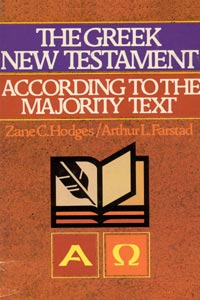
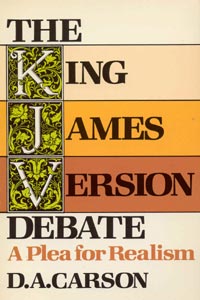
The Greek New Testament According to the Majority Text by Zane Hodges and Arthur Farstad published by Nelson, 1982. The King James Version Debate: A Plea for Realism by D.A. Carson published by Baker, 1979.
- A number of words are mistranslated by the KJV. The KJV is not a perfect
word for word translation. There is some paraphrasing like "God save
the king" (I Samuel 10:24, II Samuel 16:16, I Kings 1:25, and II
Kings 11:12). About 1,000 Greek words and particles were not translated
by the KJV. A number of words are mistranslated like John 20:17 which
says, "Touch me not" should be rendered "Do not keep on
holding me" (Lewis, 46; He lists a number of mistranslations). The
Bible was not originally divided up into verse divisions. They did not
understand Hebrew poetry. Chapter divisions are also questionable like
where Genesis one ends. The use of italics is misunderstood by readers
who put emphasis on it, instead of it being questionable reading like
"unknown tongue" in I Corinthians 14 and the speaking in tongues
movement.
- A number of words have changed in meaning from the KJV 1611. Some are
just the opposite in meaning. For example, "let" means "hinder,"
"lust" means "desire" which is not all ways bad, "fair"
means "beautiful" not just average, "quick" means
"living" and "nephews" means "grandchildren."
"Corn" means "grain" for corn was only found in North
and South America by the Indians.
- There are several animals mentioned in the KJV that are mythical:
Unicorns
The "Unicorn" is mentioned nine times in the KJV (Numbers 23:22; 24:8; Deuteronomy 33:17; Job 39:9,10; Psalm 22:21; 29:6; 92:10; Isaiah 34:7). In Deuteronomy 33:17 it says the unicorn has "horns" plural, so the KJV solved this problem by translating "unicorn" as plural "unicorns." It is an unfortunate translation of the Hebrew "reem" which means "wild ox" (BDB, 910b). It seems that the LXX translation made the error which was carried over into the Latin unicornis. The idea of a unicorn probably came from seeing a rhinoceros. In the Middle Ages when fossil tusks or horns were found, they were said to come from unicorns (Gayrard-Valy, 22). At the last ICC there were rumors of unicorns in California.
Dragons
In the Old Testament the KJV uses the term "dragon" for the Hebrew words tannim meaning "jackals" and tannin meaning "serpent, or sea monster" (BDB, 1072; Gesenius, 868-9). It seems the KJV mistranslated these two separate words. Tannim is from the root tan meaning "to howl" and tannin is from the root tanan "to smoke" (Ibid.). Jackals are known for their howling, and are associated with desolate areas. Tannin or "smokers" probably came from seeing the spouts of whales or the snorting of animals which looked like smoke coming from a fire inside. Our warm breathe in winter looks like smoke. This is probably how the idea of fire-breathing dragons started. The Hebrew is not referring to any dinosaurs.
The KJV uses the term "dragon" which comes from the Greek word drakon which means "serpent." It refers to a monster with a scaly snake like body. The Greek New Testament uses drakon 12 times only in the book of Revelation which the KJV translates as "dragon" (Rev. 12-13, 16:13, 20:2). The dragon in Revelation has seven heads similar to the leviathan in Ugaritic and Psalm 74:14 (Gibson, 50, 68; Walace, 290). Satan is called a "dragon" in Revelation 20:2.
Satyr
The Satyr is a mythical creature that was half-man and half-goat. Isaiah 13:21 and 34:14 mentions this creature in the KJV. In the Hebrew there are two more occurrences in Leviticus 17:7 and 2 Chronicles 11:15 also possibly 2 Kings 23:8. "Scholars suggest that this nom. depicts some type of demon that exhibited the likeness of a goat and was closely associated with idolatry and the high places" (New International Dictionary of Old Testament Theology & Exegesis Vol.3, 1260).
There is also the mention of the cockatrice (Isaiah 11:8, 14:29, 59:5; Jeremiah 8:17) and the arrowsnake (Genesis 49:11, margin).
- There are theological problems with the KJV. The translators are coming from a Anglican Church bias. Their view of Baptism and church comes through in the translation. Church terms are used for leaders. The words at the Lord's Table "the broken body of the Lord" (I Corinthians 11:24) are used. Some also say it has a Calvinistic bias.
Conclusions
The KJV is a good translation, but it is not perfect. It is outdated. There are better modern translations that make the Bible easier to read and understand. I like the NIV Study Bible the best.
-Dr. Stephen C. Meyers
Textus Receptus
The term "Textus Receptus" is actually a publishers blurb in the second edition of the Greek New Testament in 1633 by Elzevir brothers in Holland which says, "the text which is now received by all, in which we give nothing changed or corrupted" (Written in Latin). Elzeir's first edition in 1624 became the standard edition in Europe.
The King James Translators did not use Elzevir's edition since it was printed 13 years after the KJV 1611. The King James translators used the third edition of the Greek New Testament published by Stephanus in 1550. There are 287 differences between Elzevir's and Stephanus' editions. No Greek manuscript agrees exactly with either of these editions. These editions mainly follow Erasmus' edition published in 1516. No Greek manuscript agrees exactly with Erasmus' edition. John Mills reprinted Stephanus' third edition with a few changes in 1707 and called it the Textus Receptus. Mill's edition is the one that is still being reprinted as the Textus Receptus today(TR), but which of the 18 different editions of the TR is the right one since no two are exactly the same. See FACTS on the TEXTUS RECEPTUS and the KING JAMES VERSION.
Erasmus had only one manuscript for the Book of Revelation which was missing the last six verses in Revelation 22, so he translated back from the Latin. He used words not found in any Greek manuscript. These verses are still in the TR. Erasmus' text is different from the majority of Greek manuscripts in about 1,000 places.
Attached are passages where KJV 1611 differs from the Textus Receptus from The Authorized Edition of the English Bible (1611) by F.H.A. Scrivener, published by Cambridge University Press, 1884. Appendix E.
Questions & Answers
- Comment: People can only get saved by reading the KJV!
Reply: Our church uses the NLB (New Living Bible) and many people have been saved and added to the church. We now have four church services and we are looking for a large property to build a much bigger church. There is a church two blocks away that uses the KJV and it is dying, only about 20 people left.
- Question: What about the Dead Sea Scrolls?
Reply: The Dead Sea Scrolls were the most important archaeological discovery in the last century. Most predate the time of Christ. Parts of all the books of the Old Testament have been found except Esther. The Dead Sea Scrolls (DSS) like the magnificent Isaiah scroll closely follow the MT (Masoretic Text), but there are a few exceptions. For example, Psalm 145 is an alphabetical psalm. Each verse begins with the next letter in the alphabet, but "N" verse is missing in the MT and KJV. In the DSS it is there, so somehow a scribe left this verse out. Another important difference is in I Samuel 11 where the MT and KJV left out the first paragraph. The Longer reading in the DSS explains what happens in this chapter. It says:
"Nahash king of the Ammonites oppressed the Gadites and the Reubenites viciously. He put out the right eye of all of them and brought fear and trembling on Israel. Not one of the Israelites in the region beyond the Jordan remained whose right eye Nahash king of the Ammonites did not put out, except seven thousand men who escaped from the Ammonites and went to Jabesh-gilead" (The Dead Sea Scroll Bible translated by Abegg, Flint, and Ulrich page 225). Then verse one of I Samuel 11 starts.
- Question: What is the Majority Text?
Reply: The Majority Text is the vast majority of Greek manuscripts that agree with each other (except in minor scribal errors). The last chapter of Book of Revelation is very different in the KJV from the Majority Text and all other Greek Manuscripts.
I suggest that any KJV only person should buy a reprint of the original KJV 1611 and study that. Also, I suggest that they study Hebrew and Greek so they can check for sure if the KJV or the NIV is translated right. See the IBSS web pages on these languages.
Sincerely,
Stephen C. Meyers, Th.D.
Vice-president,
Institute for Biblical & Scientific Studies
Bibliography
The Greek New Testament According to the Majority Text by Zane Hodges and Arthur Farstad published by Nelson, 1982.
The King James Version Debate: A Plea for Realism by DA Carson published by Baker, 1979.
The English Bible from KJV to NIV: A History and Evaluation by Jack p. Lewis, published by Baker, 1981
The Dead Sea Scroll Bible: The Oldest Known Bible Translated For the First Time into English by Abegg, Flint, and Ulrich, published by HarperSanFancisco, 1999.
The Holy Bible 1611 Edition: King James Version published by Thomas Nelson Publishers, 1982; reprint of the 1611 KJV.
Translating for King James: Notes made by a translator(John Bois) of the King James's Bible translated by Ward Allen published by Vanderbilt University Press, 1969.
The Authorized Edition of the English Bible (1611) by FHA Scrivener, published by Cambridge University Press, 1884. Appendix A: Wrong reading of the 1611. Appendix B: Variations between the two issues of the 1611. Appendix C: Original readings of 1611 restored. Appendix D: Dr. Blayney's Report. Appendix E: The Greek text adopted by the 1611; I. Passages that differ from Stephanus (1550) and Beza (1589, & 1598), II. Passages that 1611 agrees with Beza against Stephanus. III. Passages 1611 agrees with Stephanus against Beza. List of passages 1611 agrees with the Latin Vulgate.
